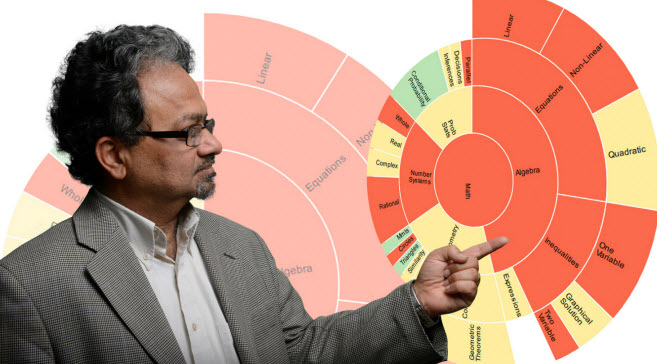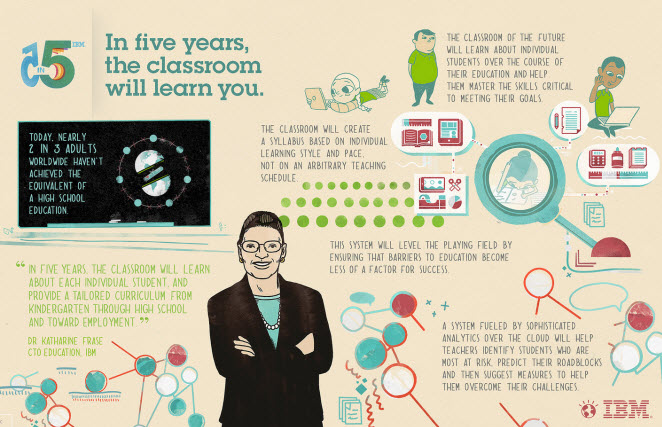IBM revealed its predictions for five big innovations that will change our lives within five years.
The IBM “5 in 5” is the eighth year in a row that IBM has made predictions about technology, and this year’s prognostications are sure to get people talking. We discussed them with Bernie Meyerson, the vice president of innovation at IBM, and he told us that the goal of the predictions is to better marshal the company’s resources in order to make them come true.
“We try to get a sense of where the world is going because that focuses where we put our efforts,” Meyerson said. “The harder part is nailing down what you want to focus on. Unless you stick your neck out and say this is where the world is going, it’s hard to you can turn around and say you will get there first. These are seminal shifts. We want to be there, enabling them.”
(See our complete interview with Meyerson here).
In a nutshell, IBM says:
- The classroom will learn you.
- Buying local will beat online.
- Doctors will use your DNA to keep you well.
- A digital guardian will protect you online.
- The city will help you live in it.
Meyerson said that this year’s ideas are based on the fact that everything will learn. Machines will learn about us, reason, and engage in a much more natural and personalized way. IBM can already figure out your personality by deciphering 200 of your tweets, and its capability to read your wishes will only get better. The innovations are being enabled by cloud computing, big data analytics (the company recently formed its own customer-focused big data analytics lab), and adaptive learning technologies. IBM believes the technologies will be developed with the appropriate safeguards for privacy and security, but each of these predictions raises additional privacy and security issues.
As computers get smarter and more compact, they will be built into more devices that help us do things when we need them done. IBM believes that these breakthroughs in computing will amplify our human abilities. The company came up with the predictions by querying its 220,000 technical people in a bottoms-up fashion and tapping the leadership of its vast research labs in a top-down effort.
Here’s some more detailed description and analysis on the predictions.
The classroom will learn you
Globally, two out of three adults haven’t gotten the equivalent of a high school education. But IBM believes the classrooms of the future will give educators the tools to learn about every student, providing them with a tailored curriculum from kindergarten to high school.
“Your teacher spends time getting to know you every year,” Meyerson said. “What if they already knew everything about how you learn?”
In the next five years, IBM believes teachers will use “longitudinal data” such as test scores, attendance, and student behavior on electronic learning platforms — and not just the results of aptitude tests. Sophisticated analytics delivered over the cloud will help teachers make decisions about which students are at risk, their roadblocks, and the way to help them. IBM is working on a research project with the Gwinnett County Public Schools in Georgia, the 14th largest school district in the U.S. with 170,000 students. The goal is to increase the district’s graduation rate. And after a $10 billion investment in analytics, IBM believes it can harness big data to help students out.
“You’ll be able to pick up problems like dyslexia instantly,” Meyerson said. “If a child has extraordinary abilities, they can be recognized. With 30 kids in a class, a teacher cannot do it themselves. This doesn’t replace them. It allows them to be far more effective. Right now, the experience in a big box store doesn’t resemble this, but it will get there.”
Buying local will beat online
Online sales topped $1 trillion worldwide last year, and many physical retailers have gone out of business as they fail to compete on price with the likes of Amazon. But innovations for physical stores will make buying local turn out better. Retailers will use the immediacy of the store and proximity to customers to create experiences that online-only retail can’t replicate. The innovations will bring the power of the Web right to where the shopper can touch it. Retailers could rely on artificial intelligence akin to IBM’s Watson, which played Jeopardy better than many human competitors. The Web can make sales associates smarter, and augmented reality can deliver more information to the store shelves. With these technologies, stores will be able to anticipate what a shopper most wants and needs.
And they won’t have to wait two days for shipping.
“The store will ask if you would like to see a certain camera and have a salesperson meet you in a certain aisle where it is located,” Meyerson said. “The ability to do this painlessly, without the normal hassle of trying to find help, is very powerful.”
This technology will get so good that online retailers are likely to set up retail showrooms to help their own sales.
“It has been physical against online,” Meyerson said. “But in this case, it is combining them. What that enables you to do is that mom-and-pop stores can offer the same services as the big online retailers. The tech they have to serve you is as good as anything in online shopping. It is an interesting evolution but it is coming.”




